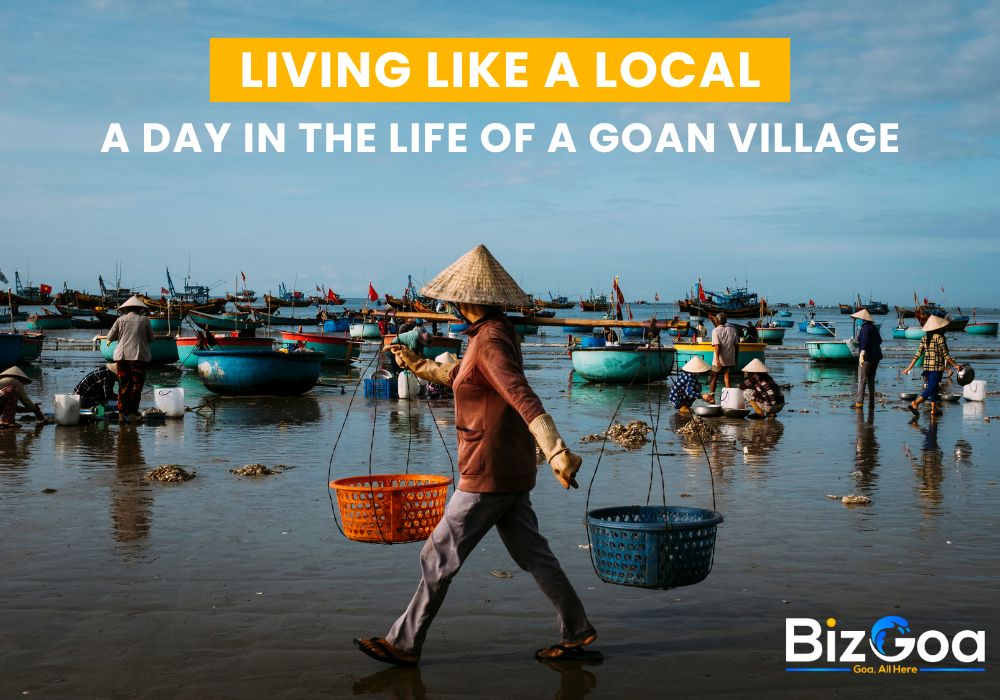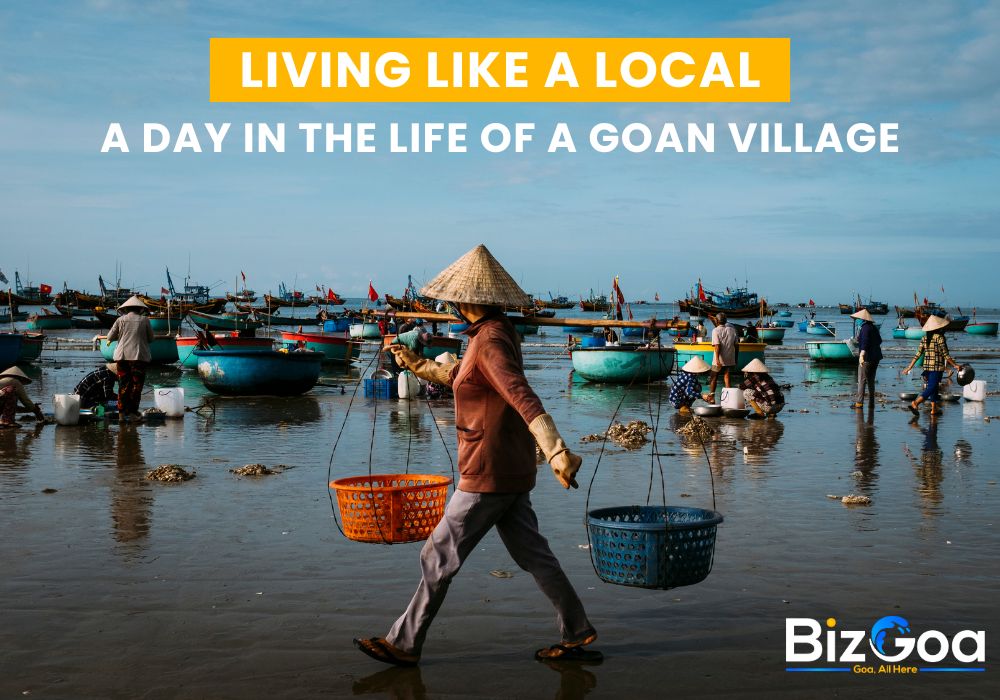- Admin
- Oct 23, 2025
- Recommended
Living Like a Local: A Day in the Life of a Goan Village Experience
Goa, the Indian beach capital, is famous for its golden sands, energetic events, and colonial structures. However, beneath the façade of tourist attractions lies the tranquility of: Goan village life. Experience a day at Goa's Goan village provides an experience that goes beyond just offbeat excursions. It's the chance to experience the local Goan culture, customs, as well as the rhythms of everyday life that have stayed beautifully unchanged for generations.
If you're looking for authentic Goan experience and are interested in what life is like in a Goan village or thinking of taking a trip to Goa where you feel more authentic than luxurious. The following blog post will guide you through the delights living in rural Goa.
Morning in an Goan village: Sharing the morning to Nature
The Quiet Symphony of a Goan Morning
In contrast to the humming streets of Goa's city centres as well as the loud beach shacks, the mornings in Goan village are greeted by natural sounds like the crowing of the rooster's crow, the rustling of coconut trees as well as the distant chime of a church bell. The majority of Goan homes in villages are hidden in the palm groves and are with rice fields surrounding them and dirt tracks.
The air is fragrant with Jasmine and dew, and the locals rise early to tend their gardens, get water, or set off the fires in their kitchens. The day is about to begin. day when time is slow and the entire community is in a single direction.
Traditional Goan Breakfasts
The typical breakfast is the poi (local bread) and coconut chutney as well as black tea, also known as the kapi (coffee). In some areas, in particular South Goa, it is possible to find freshly baked rice cakes (sanna) or bananas boiled and jaggery. The healthy start is a reflection of the simple life of everyday life in Goa.
The Daily Grind: Work, Community, and Connection
Occupations Rooted in Heritage
There is a chance to wonder what is the lifestyle of the Goans?
Much of their lives revolve around the traditional occupations. Fishing, farming or toddy tapping as well as smaller-scale trade are typical in rural areas. These aren't just a way of earning money, but an opportunity to preserve traditions of Goa as well as sustaining the Goan lifestyle.
The most popular school topic in texts is the daily life of a baker from the Goan village (Class 10). Also known as "pader," the village baker is a prominent figure. In the present the bamboo basket packed with bread warms up and is anticipated with great anticipation in many households.
Women and the Village Economy
Women are a significant part of the equation, usually managing livestock, household chores and helping out with the work in the fields. Women also make local crafts as well as pick coconuts or manage small businesses like home-made pickle-making businesses. Goa is a community-based city. Goa is based on collaboration sharing resources as well as respect for the environment.
Midday: Culture, Cuisine, and Siesta
An Insight in Local Goan Culture
The culture is part of the fabric of daily everyday life in Goa villages. Catholic practices as well as Portuguese influence throughout Goa are seamlessly integrated with Indian practices. The chapel, the folk dances such as Fugdi and Dekhni as well as the local Konkani music echoes through the streets at festivals.
The majority of houses feature Azulejos (Portuguese ceramic tile) and wooden balconies and courtyards that are open--a nod towards the colonial architecture of the time that is characteristic to Goan village homes..
The Joy of Local Cuisine
The lunch served in the dining room of a Goan local dish or in a home of the locals is an incredibly filling meal. There's fish curry, rice along with fried mackerel and seasonal veggies, all seasoned by kokum, coconut as well as traditional masalas. Food is far less spice-driven and is more about the soul.
The food is usually served with leafy greens or thalis made of steel and the host will explain the origins of each ingredient. It's a fantastic method to get a taste of Goan cuisine Goa and learn about Goan tradition by tasting.
Siesta - The Sacred Pause
At noon, the temperature increases, and the entire village slows. Stores shut, kids sleep as do animals, who retreat to shade. The easy village lifestyle also includes the well-loved siesta--a method Goa has inherited by the Portuguese and that locals are still adamant about.
Afternoon: Craft, Learning, and Leisure
Schools and Skill Sharing
If you look into the local school and see children barefoot dressed in uniforms, reciting the prayers or rhymes in Konkani as well as English. What is the way of living in Goa?--It's holistic. The values and knowledge of Goa are handed down informally as well as informally. Elders instruct children with the ropes of coconut trees. They also teach children to identify the plants that grow in their gardens, or make fishing nets.
Villages such as Loutolim, Aldona, and Chandor provide Goa tourism department of culture as well as retreats for villages in Goa which allow visitors to be taught pottery, weave or cook traditional meals.
The Artisans of the Countryside
Artists who work in their courtyards can be seen everywhere sculpting clay, weaving baskets or illustrating religious symbols. These arts are closely tied to Goan tradition and can be found at local markets, or even exported to cities nearby.
The time of the day makes it ideal to enjoy the perfect Goa offbeat experience --whether it's drinking feni while sitting under the mango trees or getting together with the villagers for a fun match that involves Lagori or Kabaddi.
Evening: Faith, Festivity, and Family
Spiritual Anchors
When the sun is beginning to set, the villagers usually go to the local church or a temple. Faith and prayer are central to the Goan lifestyle as well as every village is home to a spiritual heart. There is a chance to see the traditional praying walking around or even hear the bhajans that are sung by the mandap.
Goan evenings are quiet with reflection, social, and peaceful. Elders relax outside, adorned with Rosaries, ladies chat while washing the fish, while children play one another barefoot through the fields.
Community and Festivities
The evening is also the time when the preparations for weddings, festivals and the tiaras (Goan theater) take place. No matter what it is, Sao Joao (monsoon festival), Shigmo (spring carnival) or just a simple celebration in the church, the whole village becomes lively.
It's the moment where you truly understand what life is like in a Goan village--it's joyful and spiritual as well as personal yet communal.
Night: A Blanket of Stars and Stories
When the meal (usually the curry, rice and fried Prawns) is over, family members gather outside to chat. Tales of past Portuguese landlords and pirate sightings or the mystery woman dressed who was dressed in white are shared. There is not much light pollution. Goa's countryside provides a stunning panorama of the night sky.
It's a beautiful peace. If you're in a Goan village-based homestay you have the time to reflect, communicate with the locals or enjoy the nighttime symphony of crickets, frogs and the rustling of palms.
How to Experience Goa Like a Local
If this day of adventure has inspired you to travel There are many methods to discover real Goan experience Beyond the beach:
1. Stay in a Goan Village
Find eco-friendly resorts, Goan village homestays as well as Village retreats located within Goa. Hotels in Saligao, Aldona, and Canacona provide sustainable accommodation.
2. Join a Cultural Workshop
From the feni-making process to painting tiles Many villages provide an interactive experience. Take a look at Goa excursions that are culturally led by local guides.
3. Visit Weekly Markets
Mapusa, Margao, and smaller village bazaars are the perfect way for sampling local food--spices, handmade crafts, vegetables grown at home and the feni.
4. Cycle or Walk
Paddy fields to walk through or riding along forests, or simply welcoming the locals at every turn provides a Goa unique trip.
Why Visit a Goan Village?
Some might wonder, "Why visit a Goan village?" The reason lies in the things that urban existence lacks: warmth of community, slow days, depth of culture and the sense of belonging.
Being a part of the Goan village lifestyle will allow you to experience the lives of people who live there--not as tourists, but rather as an insignificant part of their daily lives. It doesn't matter if it's the beckon from the baker's ear, the joy of children in the water fountain, or the solitary admiration of a chapel in the evening. This is the everyday Goa--timeless as well as textured and authentic.
To get more resources or to know about more Goa villages, visit BizGoa.
FAQs
1. What's life like in a Goan village?
The life in the Goan village is tranquil at a slower pace, but also very connected to the natural world as well as the community. The daily routine includes agriculture and fishing, making traditional meals and hosting festivals of the culture.
2. What is the way that locals live in Goa?
The people of Goa reside in a simple, sustainable way. They are dependent on their local sources, employ agriculture, or small-scale trades and cherish the value of tradition, family ties and religion.
3. What are the things you can expect from the Goan village?
I look forward to beautiful Portuguese-style houses with lush greenery, welcoming people, markets for locals and temples, chapels, and a strong sense of community.
4. What was the daily routine of the bakers in a Goan village?
The village baker, also known as"pader "pader," was a revered persona. He would deliver fresh bread every day and was a key player in Goan community life as well as the customs.
5. How can I experience Goa like a local?
Staying in a Goan homestay, enjoying local food, attending local festivals, talking to the locals and visiting remote villages either on foot or on bicycles.
Final Thoughts: A Day to Remember
The day spent in the life of a Goan village isn't just an adventure. It's a narrative. It's about understanding the nature of the life of Goa and understanding the richness of simplicity. Although Goa's beaches shine with glee, it's inner towns which are the heart of Goa.
If you're planning a vacation in Goa take a step off the sand and into the backyard of Goa's soul.
Stay. Connect. Live like a local.




Share on